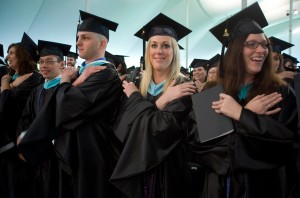
The tassels have turned on the Class of 2011. Those who trained to teach, and to do just about anything that is not über-technical, must now contemplate a tough job market as it plays out in reality and not in final-exam blue books.
The graduates from 2008 and earlier were not dealing with the challenging job market new grads are facing. With the downsizing of teaching staff in many New York districts, those coming out with teaching degrees are finding it more difficult to get a foothold in the industry. Nearby states are likewise trimming teaching and support staff; in New Jersey the teachers and the governor are, politely, hardly speaking.
The John J. Heldrich Center for Workforce Development at Rutgers University reported 2011 graduates in all fields, not just teaching, are being hit with a 10 percent “penalty” when matched against the starting job salaries of their pre-recession counterparts. While the 2008 graduate could expect a starting salary of $30,000, today”™s graduates are finding $27,000 the median entry level position salary.
Joe Weglarz, executive director of Student Financial Services at Marist College in Poughkeepsie, definitely feels for those who expected the teachers”™ market to be robust upon graduation.
“We have not made any cuts in our teaching program ”“ and most of the students entering it as freshman are expecting that there will be a turnaround by the time they graduate,” said Weglarz.
Along with the rise in those seeking employment, tuitions will rise at the school IBM built, as they are in so many others. “The cost of business ”“ compensation, salaries and benefits, as well as financial aid, is a big component of the increase. We”™ve been able to maintain it at a minimal level ”“ 4.2 percent,” said Weglarz.
The Class of 2012 is expected to be approximately 1,200 students, 200 more than Marist has traditionally accommodated. “We do expect approximately 50 of those will ”˜melt”™ this summer, and we do have a campus in Florence, Italy, which is for freshman; 55 students are enrolled on that campus, so it”™s manageable,” added Weglarz.
Although Marist does not get many Pell Grant recipients, Weglarz said the college is trying to help more families take advantage of them when they can and to make the program more enticing. Between 75 percent and 80 percent of graduating students have student loans to pay.
“At private colleges, it is expected students will participate in a loan program,” said Weglarz. “The federal government”™s loan program is one of the better ones. They do offer incentives for paying it back, including allowing graduates to deduct some of the interest.”
Weglarz said despite the downsizing of teachers in New York, its teaching program is strong. “Many of our students will go where the jobs are,” he said. “The predominant area we draw from is New York, New Jersey and Connecticut. I believe students want to stay in the area and are not looking to move away ”“ that becomes a consideration when there are no opportunities for them at home. As far as Marist, we have not cut back on any of our programs.”
Of those polled by the Center, 53 percent are working full-time, 7 percent part-time and 7 percent remain unemployed. Women, despite some gains in shattering the glass ceiling, are still making less than their male counterparts.
And what about those college loans? While many parents helped finance college tuition by borrowing against their homes before the recession hit, most take out student loans, fully expecting an immediate position to help them start repaying them. The 2011 job market has not been nearly as promising as it was before the recession.
With college tuition debt is surpassing consumer credit card interest debt.  Those who choose to ignore it only face consequences, said Weglarz. “Marist has been fortunate. Our default rate is below the national average….but if students don”™t repay their government loans, they will find liens against their tax returns. Eventually, they will have to pay, and that includes the penalties.”
College is looking better and better to students who see no job prospects without that coveted diploma, and many are choosing to continue their education while the job market strives to come back to life ”“ as a result of rising enrollment, schools in the region are meeting the need by growing.
Mt. St. Mary recently purchased the 13-acre Dominican Sisters”™ home on its campus, which will eventually house additional classrooms and dorm rooms while retaining the chapel. The restoration will be funded by a capital campaign, according to Fr. Kevin Mackin, the college”™s president, who expects to open its doors in 2013. Currently, nearly 2,700 full and part-time students attend the Mount.
At Marist, its newly opened Hancock Center, approximately 45,000 square feet, will offer more classroom space and house the computer system department. The Department of Transportation is currently working with the school to build a tunnel under Route 9, so faculty and students can cross the busy highway. That addition is expected to be ready when students return in September.
For those finding the possibility of private school beyond their financial means, community college tuitions are up, too. SUNY Sullivan announced tuition will be raised by 7.4 percent to close its $1 million-plus budget gap.



















